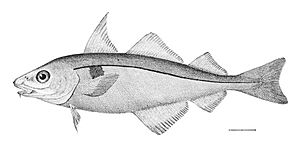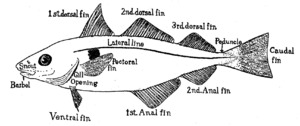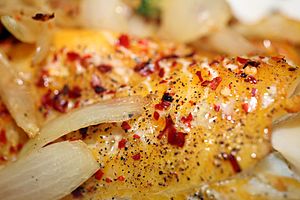Haddock facts for kids
The haddock (Melanogrammus aeglefinus) is a saltwater fish found in the North Atlantic Ocean and associated seas.
The haddock is easily recognized by a black lateral line running along its white side (not to be confused with pollock which has the reverse, i.e., white line on black side) and a distinctive dark blotch above the pectoral fin, often described as a "thumbprint" or even the "Devil's thumbprint" or "St. Peter's mark".
Haddock is most commonly found at depths of 40 to 133 m (131 to 436 ft), but has a range as deep as 300 m (980 ft). It thrives in temperatures of 2 to 10 °C (36 to 50 °F). Juveniles prefer shallower waters and larger adults deeper water. Generally, adult haddock do not engage in long migratory behaviour as do the younger fish, but seasonal movements have been known to occur across all ages. Haddock feed primarily on small invertebrates, although larger members of the species may occasionally consume fish.
Haddock range in size between 38 and 69 cm (15 and 27 in) in length and 0.9 and 1.8 kg (2.0 and 4.0 lb) in weight. Growth rates of haddock have changed significantly over the past 30 to 40 years. Presently, growth is more rapid, with haddock reaching their adult size much earlier than previously noted. However, the degree to which these younger fish contribute to reproductive success of the population is unknown. Growth rates of haddock, however, had slowed in recent years. Some evidence indicates it may be the result of an exceptionally large year class in 2003. One Spawning occurs between January and June, peaking during late March and early April. The most important spawning grounds are in the waters off middle Norway, near southwest Iceland, and Georges Bank. An average-sized female produces approximately 850,000 eggs, and larger females are capable of producing up to 3 million eggs each year.
Contents
Fisheries
Reaching sizes up to 1.1 m (43 in), haddock is fished year-round. Some of the methods used are Danish seine nets, trawlers, long lines and fishing nets. The commercial catch of haddock in North America had declined sharply in recent years, but is now recovering, with recruitment rates running around where they historically were from the 1930s to 1960s.
As food
| Nutritional value per 100 g (3.5 oz) | |
|---|---|
| Energy | 469 kJ (112 kcal) |
|
0.0 g
|
|
| Dietary fiber | 0.0 g |
|
0.93 g
|
|
|
Protein
|
24.24 g
|
| Vitamins | Quantity
%DV†
|
| Thiamine (B1) |
3%
0.040 mg |
| Riboflavin (B2) |
4%
0.045 mg |
| Niacin (B3) |
29%
4.632 mg |
| Pantothenic acid (B5) |
3%
0.150 mg |
| Vitamin B6 |
27%
0.346 mg |
| Folate (B9) |
3%
13 μg |
| Vitamin C |
0%
0.00 mg |
| Minerals | Quantity
%DV†
|
| Calcium |
4%
42 mg |
| Iron |
10%
1.35 mg |
| Magnesium |
14%
50 mg |
| Phosphorus |
34%
241 mg |
| Potassium |
13%
399 mg |
| Zinc |
5%
0.48 mg |
| †Percentages estimated using US recommendations for adults. | |
(Several unreferenced statements in below paragraphs)
Haddock is a very popular food fish, sold fresh, smoked, frozen, dried, or to a small extent canned. Haddock, along with Atlantic cod and plaice, is one of the most popular fish used in British fish and chips.
Fresh haddock has clean, white flesh and can be cooked in the same ways as cod. Freshness of a haddock fillet can be determined by how well it holds together, as a fresh one will be firm; also, fillets should be translucent, while older fillets turn chalky (nearly opaque). Young, fresh haddock and cod fillets are often sold as scrod in Boston, Massachusetts; this refers to the size of the fish which have a variety of sizes, i.e., scrod, markets, and cows. Haddock is the predominant fish of choice in Scotland in a fish supper. It is also the main ingredient of Norwegian fishballs (fiskeboller).
Unlike the related cod, haddock does not salt well and is often preserved by drying and smoking.
The smoking of haddock was highly refined in Grimsby. Traditional Grimsby smoked fish (mainly haddock, but sometimes cod) is produced in the traditional smokehouses in Grimsby, which are mostly family-run businesses that have developed their skills over many generations. Grimsby fish market sources its haddock from the North East Atlantic, principally Iceland, Norway and the Faroe Islands. These fishing grounds are sustainably managed and have not seen the large scale depreciation in fish stocks seen in EU waters.
One popular form of haddock is Finnan haddie which takes its name from the fishing village of Finnan or Findon in Scotland, where it was originally cold-smoked over peat. Finnan haddie is often served poached in milk for breakfast.
The town of Arbroath on the east coast of Scotland produces the Arbroath smokie. This is a hot-smoked haddock which requires no further cooking before eating.
Smoked haddock naturally has an off-white colour; it is very often dyed yellow, as are other smoked fish. Smoked haddock is the essential ingredient in the Anglo-Indian dish kedgeree, and also in the Scottish dish "Cullen Skink" (a 'chowder' like soup).
Images for kids
See also
 In Spanish: Eglefino para niños
In Spanish: Eglefino para niños






